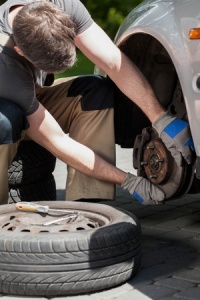Should I Warm Up My Car When It’s Cold Out?
 The temperatures are slated to drop significantly over the next few days, but that doesn’t mean everyone can just curl up with a blanket until spring returns. People still have to get to work or the grocery store, and many times they’ll start their car and let it run for a few minutes before driving off. Today, we’ll explain if it’s really a good idea to let your car warm up when it’s cold out.
The temperatures are slated to drop significantly over the next few days, but that doesn’t mean everyone can just curl up with a blanket until spring returns. People still have to get to work or the grocery store, and many times they’ll start their car and let it run for a few minutes before driving off. Today, we’ll explain if it’s really a good idea to let your car warm up when it’s cold out.
Start Your Engines
Before we answer the question, let’s begin by examining how a modern engine works. Many of today’s engines use an electronic fuel injection system, which helps regulate how much fuel gets into the engine depending on a variety of factors, one of which is temperature.
When the temperature is cold, the fuel injectors stay open longer to allow more fuel into the engine. This helps the engine run while it’s cold, which in turn leads to a warmer engine. Based on that alone, it might seem like a good idea to let your car run for 10 minutes before you drive off so the engine can get up to optimal temperature, but that’s not the case for a couple of reasons.
First, keeping your car in idle is the slowest way to bring your engine up to normal operating temperature. Your car will get to its optimal operating temperature faster if you let it idle for a minute or two, then ease into a drive. Don’t go from 0 to 55 mph if you can avoid it.
Secondly, letting your car sit in the idle position can actually do more harm than good. Your exhaust system operates by burning off unburned hydrocarbon emissions. A cold car gives off a higher percentage of unburned hydrocarbons than a warm engine, and even at the optimal temperature your catalytic converter can’t burn off all the unburned emissions. If your engine takes a long time to warm up because you only let it idle, you can end up with a plugged catalytic converter, which can lead to a slew of related problems, like decreased gas mileage, dirtier exhaust, and costly repair bills.
The Answer
So what’s the best method for starting your car? There are two basic rules of thumb to follow, depending on the temperature.
If the temperature is above freezing: This is the most common case people face throughout the winter. If the temperature is above freezing, your best bet it to let your car warm up for 60-90 seconds before driving off. In the first few minutes on the road, take it easy while accelerating. Using this method, you’ll warm your engine up quicker, which helps keep your catalytic converter running smoothly, and you’ll waste less gas by not sitting idly.
If the temperature is below freezing: If temps are in the negative, or if you heading out to work in the early morning after a particularly cold night, let your car warm up a little longer. Give it 3-5 minutes to warm up, and then drive off slowly.
Related source: Mother Earth News
-
5 Things To Do In The Fall In Minnesota
 Oct 16, 2013
Oct 16, 2013Picturesque Minnesota is bustling with life during the fall, and many people hop in the car to check out the state’s beautiful landscape and attractions. To help you in your search for fun fall activities in Minnesota, we complied a list of five places to drive to before it gets too cold. In the event […]
-
3 Minor Car Repairs That Can Save You Major Dollars
 Sep 24, 2014
Sep 24, 2014Nobody likes to have repair work done on their car, but answer this question. Would you rather spend $200 now to fix a small problem, or $1,000 three months from now to fix a major issue? Obviously, you’d rather address the minor issue before it becomes a major headache. The thing is, most people ignore […]
-
3 Car-Related New Year’s Resolutions You Should Keep
 Jan 2, 2014
Jan 2, 2014Happy 2014! Now that we’ve flipped the calendar to January, it’s time to look at your resolutions for the new year. Many people want to eat better or work out more, but others are more creative when it comes to New Year’s resolutions. We like to think we’re a creative bunch, so we’ve come up […]




